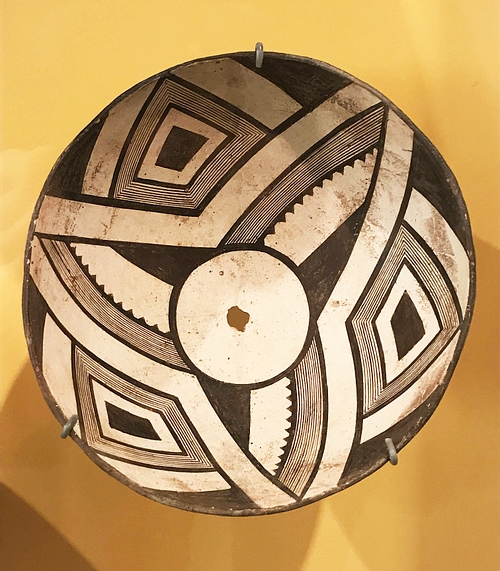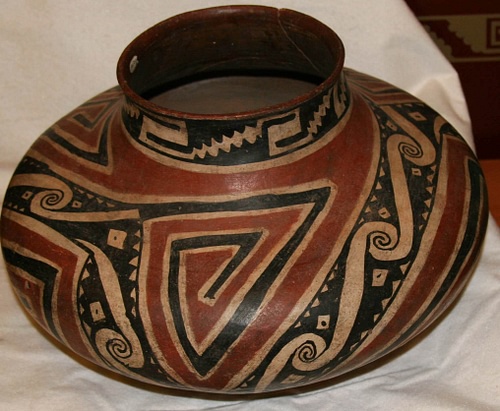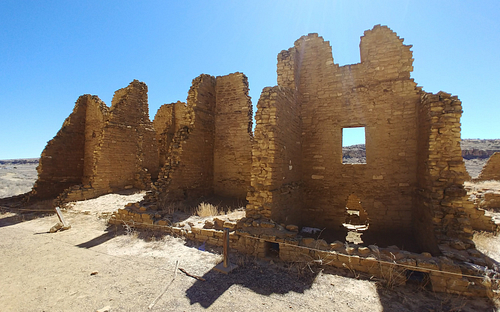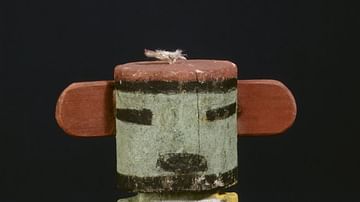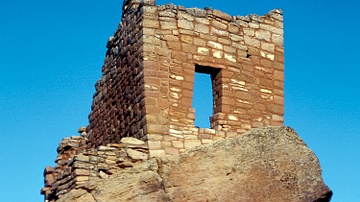Pre-Columbian civilizations of the Southwestern United States and Northern Mexico include the Hohokam who occupied the US state of Arizona, the Anasazi or Ancestral Pueblo Peoples who resided in the Four Corners Region, and the Mogollon who inhabited southern New Mexico and northern portions of Chihuahua in Mexico. These cultures flourished for hundreds of years before the arrival of the Spanish conquistadores in the 16th century CE. They each left an indelible cultural imprint upon the region, which endures today. Nonetheless, their impressive achievements in the domains of art, architecture, and engineering remain too often underappreciated and little studied even in the United States.
In this exclusive interview, Ancient History Encyclopedia's Communications Director, James Blake Wiener, speaks to Professor Steven Lekson of the University of Colorado Boulder on the importance of the wider interconnections between the ancient cultures of Oasisamerica in addition to the state of research in the field of Southwestern archaeology.
JBW: Professor Lekson, it is a real privilege to welcome you to AHE, and I thank you for speaking with me about the ancient cultures of the Southwestern United States.
The general public seems to know relatively little about the Ancestral Puebloans who dominated the Four Corners Region between c. 900-1300 CE. Could you tell us more about the recent discoveries and the research that is currently undertaken? Which among the new discoveries do you find critical or crucial in helping us establish the rise, fall, and everyday life of the Ancestral Puebloans?
SL: Perhaps the most important new development in our understanding of the Ancestral Pueblo (Anasazi) peoples of the Four Corners (the area around the joint corners of Colorado, Utah, Arizona, and New Mexico) is the pivotal role of Chaco Canyon, the 11th-century CE regional center in northwestern New Mexico. Chaco Canyon is the site of a half-dozen Great Houses – monumental sandstone structures of up to 500 rooms, that rose up to five stories and covered over one hectare of area.
For many years Great Houses were considered exceptionally nice farming villages, but it is becoming more and more likely that they were palaces for a nobility that ruled over up to 60,000 commoners, in a region of 100,000 square kilometers (38610 square miles), encompassing such famous sites as Mesa Verde, Hovenweep, and Canyon de Chelly. Recent research shows that vast quantities of goods were brought into Chaco Canyon, the capital, even from a great distance and the central noble family of Pueblo Bonito (the largest of the palaces) was a matrilineal dynasty that lasted several centuries.
Modern Pueblo people are descendants of Chaco and Mesa Verde, but they conspicuously avoid the kinds of hierarchies and wealth and social class evident at Chaco. Pueblos are famously egalitarian – they have no nobles, kings or capital city. It is likely that the unique Pueblo social structures arose in reaction and rejection of the hierarchies of Chaco, which ended badly. About 1090 CE, the capital shifted north to Aztec Ruins National Monument, but the new capital could not maintain the peace and prosperity of Chaco's reign. Droughts and violence led ultimately to the abandonment of the Four Corners region by tens of thousands of Ancestral Pueblo people; most of whom moved to join the modern Pueblos, from the Hopi Pueblos in Arizona on the west, through Zuni and Acoma, to the many Pueblos of the Rio Grande in New Mexico in the east. Chaco's nobles may have moved south toward fellow nobles in Mesoamerica, and helped to found Paquimé (Casas Grandes), the Southwest's last great city.
JBW: The Hohokam, who lived in present-day Arizona, distinguish themselves from their neighbors by virtue of the longevity of their culture. The Hohokam constructed impressive settlements, sophisticated irrigation canals, and even built ritual ball-courts that mirror those found in Mesoamerica. Is there evidence of significant cultural or material exchange between the Hohokam and the Ancestral Puebloans, and how should we characterize their unique role and legacy in the Southwest?
SL: Hohokam civilization comes into focus around 500 CE; they prospered along the major rivers of the deserts of southern Arizona, 500 km (311 miles) from the Four Corners and Chaco Canyon. At Chaco and throughout the Four Corners, rainfall farming was (barely) possible, but in the Hohokam deserts – with far less precipitation – farming absolutely required irrigation. Huge canal systems on the Salt and Gila Rivers (channeling waters from the Mogollon uplands) underwrote its thousand-year history.
Hohokam houses were one-room mud-and-thatch structures, rising from a slightly sunken floor ("pit houses" or "houses-in-pits"). Three or four of these house structures faced into a small shared patio; a dozen or more of these patio groups formed a village segment, often with its own cemetery; and multiple village segments surrounded a large public central plaza. On the edge of the settlement were one or two oval ball-courts, different from the rectangular or "I"-shaped ball-courts of Mesoamerica.
Unlike the black-on-white pottery of Ancestral Pueblo peoples, Hohokam pottery was red-on-buff, with reddish-brown painted designs on a light tan or buff background. Other aspects of Hohokam material culture were equally characteristic: a well-developed industry of shell jewelry manufacture, elaborate sculpting of stone vessels, and brilliant weaving of Hohokam-grown cotton.
Hohokam peaked at about 900 CE, but after 1000 CE, it shrank back into its original core area in the Phoenix Basin. Ball-courts, previously the center of civic life, were no longer built or even used. A new form of public architecture appeared; platform mounds. These rectangular earth-filled structures reached sizes of 50 m by 95 m, standing over 7 m tall. On the flat upper surface of these mounds stood the substantial adobe homes of a new Hohokam leadership – prior to the platform mounds, archaeology has not revealed any evidence of an elite. The new regime was marked by new pottery: a striking, colorful new type, Gila polychrome, appeared in large quantities alongside the older types. The great civilization ended around 1450 CE, perhaps in a class revolt of the commoners against the platform mound rulers (as recalled in Native stories).
Obviously, the Southwest's two biggest cultures of the 9th-12th century CE knew each other. The timing of their respective histories – Chaco's burst of major building commenced about 1020 CE while Hohokam's decline began about 1000 CE – suggests a historical linkage, but there is little material evidence of sustained interaction. It is only in higher-value, lower-quantity artifact classes that hints appear: Hohokam shell jewelry, a Hohokam cotton garment, and other things of that nature appear at Chaco Canyon. Inter-elite exchange would probably be marked by precious materials that seldom survive: cotton, cacao, macaw feathers, or by exchange of marriage partners.
JBW: The Mimbres people were a subculture of the Mogollon, occupying southern New Mexico and the northern part of Chihuahua in Mexico. In your lectures, you have previously described them as a cultural weathervane. How has our knowledge of the mysterious Mimbres culture increased in recent years?
SL: The history of Hohokam and Chaco registered dramatically on a third contemporary, the Mimbres societies of southwestern New Mexico. Famed for their artistry on black-on-white pottery, Mimbres was sufficiently distinct to merit a third cultural designation, nominally equal to its contemporaries Chaco and Hohokam, an Anasazi/Ancestral lifestyle on a Hohokam infrastructure. Mimbres began around 500 CE with pit-houses, rather like Hohokam structures in plan but far deeper sunken floors. Around 1000 CE, Mimbres made a sudden and dramatic shift from deep pit-houses to above-ground stone-masonry pueblos. They flourished until c. 1150 CE, when Chaco ended and Mimbres collapsed simultaneously.
When Hohokam was roaring strong, Mimbres looked west and shared red-on-buff/brown pottery styles, cremation burials, shell jewelry, and canal irrigation – all Hohokam emblems – but not, as far as we know, Hohokam's ball-courts. When Hohokam retrenched back into Phoenix while Chaco expanded into most of the Four Corners, Mimbres turned away from Hohokam to the west, to the rising power in the north. Pit-houses turned into stone pueblos, red-on-brown pottery was replaced by black-on-white of sudden and surprising excellence and quality. While Mimbres was interesting in its own right, it also serves as a gigantic weathervane of ancient Southwestern geopolitics: pointing to the west from 700 to 1000 CE when Hohokam was at its peak, and then swinging north towards Chaco from 1000 to 1150 CE, as Hohokam faltered and Chaco boomed.
JBW: I cannot complete this interview without at least one question about the city of Casas Grandes or Paquimé. It was the last major city in the Southwest to emerge before the arrival of the Spanish in the 16th century CE, but it is located in Chihuahua, Mexico, rather than the United States. Professor Lekson, would it be fair to say that Casas Grandes was the heir of the Ancestral Puebloans, the Mimbres, and the Hohokam? How would you characterize Casas Grandes' importance in the history of the Southwest, and what circumstances led to its sharp rise and sudden collapse between c. 1250-1450 CE?
SL: Evidence from both art history and biological archaeology links Mimbres (which collapsed 1150 CE) with the great city of Paquimé (which rose about 1300 CE). The missing 150 years between collapse and rise played out in apparently short-lived but (sometimes) large adobe pueblos scattered across the low deserts where the Mimbres River disappears in the desert, trickling into the sands of southernmost New Mexico and northernmost Chihuahua.
The Rio Casas Grandes flows out of the Sierra Madre uplands, and in recent times its waters – flowing through extensive canals – made the arid region the breadbasket of modern northern Mexico. So, too, in ancient times: Paquimé tapped the river with long canals, echoing the larger Hohokam irrigation system; in addition, extensive check-dams and mulch fields allowed rainfall farming on the higher plains, away from the river.
Paquimé was the center and almost certainly the capital of a region comparable to Chaco's. There is evidence that at least some of the noble families from failed Chaco played a role in Paquimé's rise. Those Chaco families had ruled a diminishing realm from Aztec Ruins from 1150-1280 CE; the city of Paquimé was planned and built around 1300 CE. Key architectural elements unique to Chaco and Aztec also appear at Paquimé, and the burial modes of Paquimé's elites echo those of Chaco Canyon.
Paquimé was the last great Southwestern city and the most cosmopolitan where the Southwest and Mesoamerica finally met and for a brief time – 150 years – flourished. Classic Mesoamerican I-shaped ball-courts stood outside pueblo-like multi-storied houses and warehouses, entered via characteristically Chacoan T-shaped doors. Remarkable quantities of southern imports were stored alongside stacks of distinctive late Gila polychrome Hohokam bowls. Indeed, a local version of Gila polychrome was common; but Paquimé's "signature" ceramic was Ramos polychrome – a striking art form which owed much to earlier Mimbres traditions, but which depicted Mesoamerican deities among other things.
Paquimé ends, mysteriously, around 1450 CE, the same time that late Hohokam collapsed. Hohokam and Paquimé were peers and perhaps rivals; their simultaneous endings were surely historically linked, in ways opaque to us. The simultaneous rise-and-fall of Chaco and Mimbres, and the mutual collapse of late Hohokam and Paquimé probably reflect, in part, climate shifts, but these societies were far more than pawns of their environment. They could and did muster massive amounts of labor to construct extensive irrigation canals, controlling the harsh desert environment and raised major monuments. Societies could and did rise far above the apparent limitations of their environment, and create small yet colorful civilizations.
JBW: The Salado Culture's appearance and disappearance is yet another mystery in the ancient Southwest. They were well-known for their pottery, which was prized throughout the region. What else do we know about the Salado Culture, though?
SL: The striking Gila polychrome (red, white and black) pottery characteristic of later Hohokam (1300 to 1450 CE) is found far beyond the Hohokam heartland. Gila polychrome was one of several types of polychrome pottery, together called "Salado" after the Salt River which runs through the Phoenix Basin. While we associate Gila polychrome with late Hohokam, the Salado polychromes originated not in the Hohokam heartland but rather in the Mogollon Uplands to the north and then fully developed on the upper Gila and Salt rivers to the east. Salado polychromes then spread over a huge area (including the old Hohokam core).
The colorful types constituted small but significant proportions of ceramics across a range of cultures in an area of 500 x 600 km (311 x 373 miles). This area encompassed a half-dozen different local ceramic traditions. Remarkably, Salado polychrome pottery appears to be almost always locally made; that is, the clays used to make Salado polychromes were the same clays used for local ceramics. This is a puzzle: the designs are quite distinctive and unmistakable, but the pottery was not being produced in one place and exchanged out across the vast region.
The proportions of Gila and other Salado polychromes at sites varied. Sites with predominately Salado pottery were mostly on the upper Gila and upper Salt rivers – east of the Hohokam core – and in the uplands immediately north of these valleys. It was in the uplands that Salado pottery probably began. Sizable numbers of Ancestral Pueblo (Anasazi) migrants from northeastern Arizona entered the upper Salt and upper Gila drainages in the late 12th and 13th centuries CE. Living initially in enclaves among the local Hohokam-leaning populations, the Ancestral Pueblo immigrants mixed rapidly with the local peoples to create a hybrid society, and with it the Salado polychrome tradition.
Salado sites on the upper Salt had platform mounds, and in many other ways mirrored the Phoenix Basin Hohokam. The Salt River Salado sites fell at the same time as Hohokam, about 1450 CE. Salado sites on the upper Gila lacked platform mounds and in fact looked much more like northern "pueblos." One of the last and largest Salado "pueblos" was Kwilleylekia, on the uppermost Gila River. Based on the pottery found there, Kwilleylekia may have lasted until c. 1500 CE, if not later. Intriguingly, one 16th-century CE cemetery at an ancestral Zuni Pueblo site, 200 km (124 miles) to the north, contained many graves with Gila polychrome offerings.
SL: In your works and lectures, you emphasize the continental interconnectedness of the ancient cultures in the desert Southwest to the civilizations of Mesoamerica and the Mississippian culture. Why should scholars and archaeologists approach the study of the ancient Southwest through a continental prism?
SL: American archaeology has been very sectional, divided and even provincial, but from the onset of human colonization of the Americas, ancient histories were continental in scope. As history progressed, ancient Americans regionalized, but we should not think that localized material culture meant ignorance of the continental contexts. Chaco Canyon and the Southwest clearly knew about Cahokia and the Mississippi Valley. Much later, in 1540 CE, this was made clear when conquistadors were in search of cities and their native guides knew where to find them.
Coronado was disappointed in the Pueblos, but the Pueblos knew that across the Plains there had once been Cahokia – a monumental city of more than 20,000 people. De Soto wanted something bigger than the thatched towns of the Southeast; his guides knew that far to the west there had once been Chaco. The two expeditions – both launched in 1540 CE – almost met in the middle, near Spiro Mounds. Ten years earlier, another conquistador Nuño de Guzmán, sought cities from the south. Native guides led his army due north from Culiacán, and although he eventually turned back, the northern route would have led him straight to Paquimé – long gone, but apparently not forgotten. In the 16th century CE, Paquimé was gone for over 100 years, and Chaco and Cahokia for almost 500 years, but apparently, with indigenous ideas about time, they were still remembered as cities.
Recent research has shown us that ritually-charged "black drink" – a highly-caffeinated tea made from a plant that grows only along the coast of the Gulf of Mexico – was drunk at Chaco (and Cahokia). Recent research identified 14,000 small shells (intended for beadwork) at a famous Mississippian site, Spiro Mounds, as coming from the California Coast. Even more recently, I identified a southwestern "lace" textile at Spiro. Again, inter-elite communication with precious (and mostly) perishable rarities: tea, shell, cotton, etc.
It is important to situate the ancient Southwest in its continental context; the border between the USA and Mexico was not there a thousand years ago. Chaco Canyon is often described as a mystery because no model from ethnology or ethnohistory "fits" Chaco, but that is not true if we look across the national border. A well-known model of small-scale city-state polities from Nahua ethnohistory fits Chaco like a glove, but our narrow provincial focus had prevented us from looking beyond our borders.
JBW: I am curious to know what it was that first sparked your interest in the ancient Southwest and ultimately led you to devote your life to studying the Mogollon and Ancestral Puebloans (Anasazi) in particular? Why do you believe others ought to study the ancient Southwest, too, and what lessons can we draw from their successes and failures?
I am an accidental Southwesternist. Entering college, I thought I might become a Classical archaeologist, but a faculty advisor advised me instead to study anthropology and excavate Indian mounds. I was on a path to being a Mississippi Valley archaeologist when I joined an archaeology project in southwestern New Mexico. In the Mississippi valley and US Southeast, the heat and humidity are oppressive; ticks and chiggers and mosquitoes are everywhere; and there are a variety of poisonous snakes, some of which were alarmingly aggressive. The Southwest was wonderfully arid; its insects few and far between; and the only reptiles worth worrying about rattled to show their presence and are, in fact, rather timid. On my New Mexico dig, I saw, for the first time in my life, the Milky Way. Southwestern skies and lands are magical!
So I became a Southwestern archaeologist. There are many things of possible global interest in the Southwest (very early agriculture, for example) but I have focused on the origins and operations of government. In Chaco, for example, I think we have an excellent example of a secondary city-state: a state formed in consequence of earlier, larger political entities. Ancient city-states and secondary states are global phenomena, they occur (almost) everywhere. Chaco should contribute to their study, because of its remarkable preservation, its precise tree-ring dating, and the considerable amount of money and energy invested in Chacoan archaeology for over a century.
Too often the Southwest is held up as an example of environmental restriction, but for 1,000 years, Hohokam civilization flourished in the region's fiercest deserts, and continuous political history linked Chaco and its successor capitals, culminating in Paquimé. The collapse of ancient societies are worth our attention, but their successes should also be studied and celebrated.
JBW: Professor Lekson, what is the one question about the ancient Southwest that you would like answered sooner rather than later?
SL: To me, the most interesting big question in southwestern archaeology is something fairly new: the Early Agricultural Period of southern Arizona, which was completely unknown until salvage archaeology in the late 1980s CE. Substantial villages of small pit-houses appeared as early as 1200 BCE along the tributaries of the Gila River. These villages were supported by small canals diverting water onto fields; the canals were smaller than the later Hohokam systems, but the irrigation was very extensive and quite sophisticated. The subsequent career of the Early Agricultural Period is murky: did it survive to become Hohokam, or was it a flash-in-the-pan?
The Early Agricultural Period was contemporary with Olmec and also with the remarkable monumental center of Poverty Point on the lower Mississippi River, which rose and fell together, more-or-less simultaneously. This is not to place the modest Early Agricultural Period on the same level as mighty Olmec, but the timing is interesting. My question is what was going on in the Southwest and in North America around 1200 BCE.
Dr. Steve Lekson is an archaeologist and professor, working in the US Southwest. Most of his fieldwork has been in the Mogollon and Anasazi (Ancestral Pueblo) regions, but he has also dabbled in Hohokam, Casas Grandes, Jornada, and Rio Grande areas. His principal interests are human geography, built environments, and government; but his current research projects have more to do with migrations (Pinnacle Ruin, in southern New Mexico) and household archaeology (Yellow Jacket, in southwestern Colorado). Dr. Lekson is also interested in museums (he's the Curator of Anthropology at the University of Colorado Museum of Natural History) and archaeology's role in American and global intellectual life.



